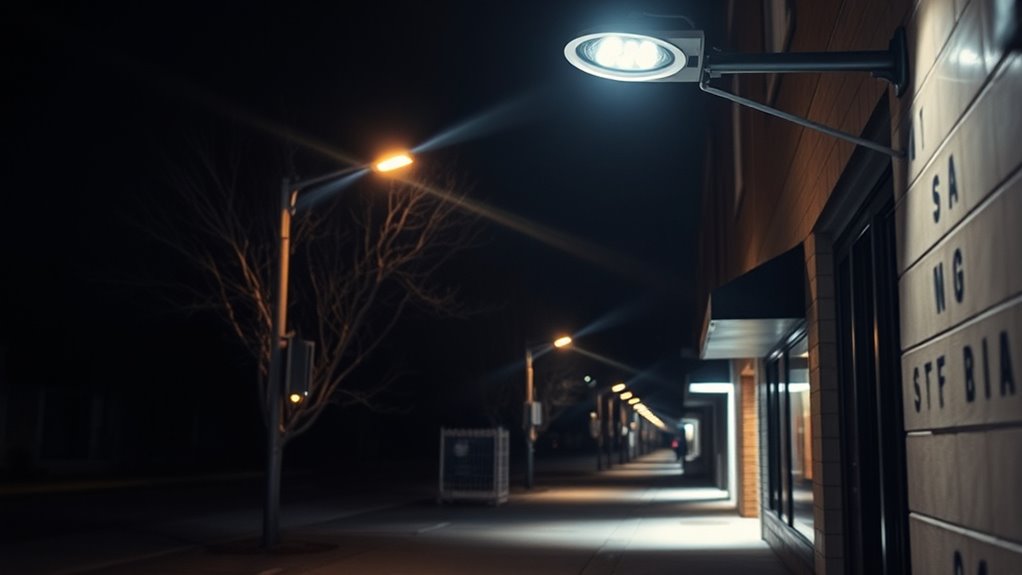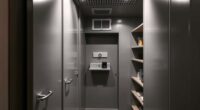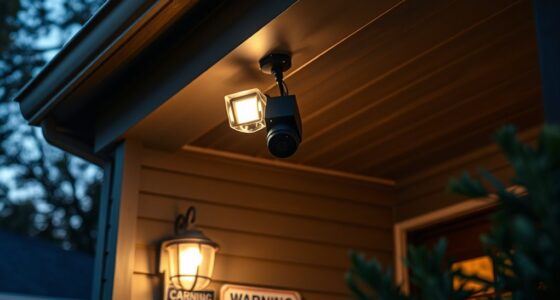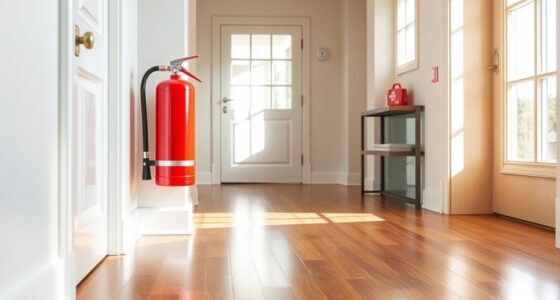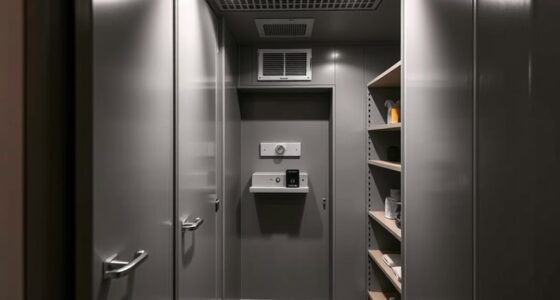Effective crime-reducing lighting involves ensuring areas are uniformly bright, focusing on key entry points, and using energy-efficient LED fixtures that highlight landscape features. Incorporate motion sensors to activate lights only when needed, and choose higher color temperatures around 5000K for better visibility. Regular maintenance and community involvement boost overall safety, while smart systems enable dynamic control. If you’re curious about how these strategies work together, there’s more to explore below.
Key Takeaways
- Well-lit, uniformly illuminated outdoor areas increase visibility and reduce hiding spots, deterring criminal activity effectively.
- Strategic placement of fixtures focusing on entry points enhances security and minimizes dark zones for offenders.
- LED lighting with motion sensors provides immediate alerts, increasing deterrence and reducing energy waste.
- Cooler color temperatures (around 5000K) improve visibility and psychological vigilance, discouraging crime.
- Community involvement and regular maintenance ensure consistent lighting, fostering safety perception and ongoing crime prevention.
The Impact of Brightness Levels on Crime Reduction
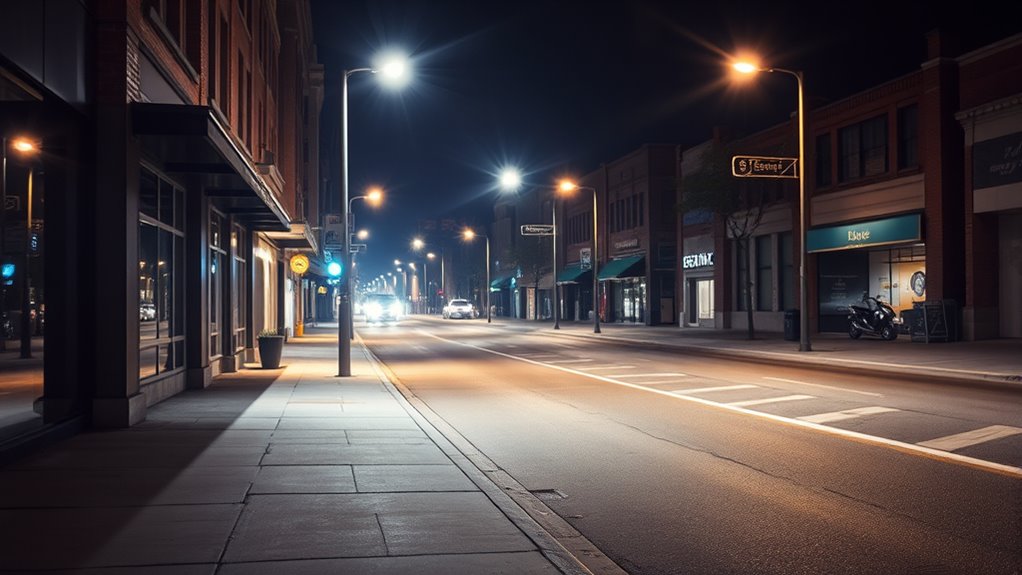
Brightness levels play a crucial role in deterring crime, as well-lit areas tend to discourage criminal activity. In urban design, strategic lighting placement enhances visibility, making it harder for offenders to operate unnoticed. High brightness levels improve natural surveillance by residents and passersby, creating a sense of safety. Incorporating advanced surveillance technology, such as cameras, is more effective when combined with proper lighting, ensuring clear footage and better monitoring. Well-lit streets and public spaces signal that authorities are vigilant, deterring potential offenders. You should focus on balancing brightness to avoid creating glare or dark spots, which criminals can exploit. Additionally, integrating Victorian-inspired lighting fixtures can add an aesthetic appeal while maintaining effective illumination. Overall, optimizing brightness levels through thoughtful urban design and surveillance integration considerably reduces the likelihood of crimes occurring.
The Role of Uniform Lighting in Public Safety

Uniform lighting plays a vital role in guaranteeing public safety by eliminating dark spots and creating consistent visibility across public spaces. When lighting is even, you reduce hiding spots for potential offenders and improve overall surveillance. Good urban design integrates uniform lighting seamlessly, enhancing safety without sacrificing aesthetic appeal. This consistency helps pedestrians and drivers feel secure during nighttime hours. To visualize, consider this table:
| Aspect | Benefits | Impact on Safety |
|---|---|---|
| Even illumination | Removes shadows and dark corners | Deters crime, improves visibility |
| Aesthetic appeal | Creates inviting, well-designed spaces | Encourages community use |
| Consistency in design | Maintains uniformity across areas | Enhances overall safety perception |
Implementing uniform lighting ensures your public spaces are both attractive and safe, fostering community confidence. Consistent lighting is also essential for integrating wall organization systems and aesthetic decor elements seamlessly.
Strategic Placement of Light Fixtures to Maximize Deterrence

You should focus on illuminating vulnerable entrances to make it harder for intruders to approach unnoticed. Position light fixtures to eliminate shadows and dark spots where offenders could hide. By strategically placing lights, you create a safer environment that discourages criminal activity. Incorporating high-quality lighting fixtures can further enhance visibility and deter potential intruders effectively.
Illuminate Vulnerable Entrances
Strategic placement of light fixtures around vulnerable entrances can substantially deter criminal activity by increasing visibility and signaling that the area is monitored. Proper lighting not only enhances safety but also preserves the landscape aesthetics, ensuring fixtures blend seamlessly with the environment. If you’re working with historic preservation, choose fixtures that complement the building’s architecture and avoid disrupting its character. Well-placed lights highlight entry points, making trespassers more visible and reducing hiding spots. This targeted lighting discourages criminal behavior while maintaining the visual integrity and charm of your property. Thoughtful placement maximizes security benefits without sacrificing the area’s historical or aesthetic appeal. Additionally, understanding crime statistics in your area can help inform where lighting will be most effective in deterring potential offenders.
Avoid Shadows and Dark Spots
To effectively deter crime, it’s essential to eliminate shadows and dark spots around your property. Shadows and dark spots create hiding places for intruders, making your space vulnerable. To address this, focus on closing lighting gaps by strategically placing fixtures. Here are three tips:
- Position lights at corners and near entry points to prevent shadows from forming.
- Use multiple light sources to eliminate overlapping shadows and ensure even coverage.
- Adjust fixture angles regularly to avoid creating new dark spots as landscaping or structures change.
- Regularly inspect your lighting system and drivetrain components to ensure all fixtures are functioning correctly and providing consistent illumination.
The Benefits of LED Lighting for Crime Prevention

LED lighting offers you improved visibility and coverage, making it harder for potential offenders to hide. Plus, it’s energy-efficient, saving you money on electricity bills over time. These benefits make LED lighting a smart choice for enhancing safety and reducing crime. Incorporating protective styling benefits into your outdoor lighting design can further deter unwanted activity.
Enhanced Visibility and Coverage
Because they emit bright, consistent light, LED fixtures considerably improve visibility in public spaces, making it easier to spot potential threats. This enhanced coverage reduces dark spots and blind corners that criminals exploit. The even illumination also highlights landscape aesthetics, creating a welcoming environment that discourages illicit activity. Additionally, decorative fixtures can be integrated seamlessly into design, maintaining aesthetic appeal while boosting safety.
Key benefits include:
- Increased overall visibility across large areas, helping you monitor activity effectively.
- Better coverage of alleys, walkways, and parking lots, reducing hiding spots.
- Improved ambiance with well-placed fixtures that blend safety with landscape aesthetics, deterring crime without sacrificing visual appeal.
Energy Efficiency and Cost Savings
Building on the improved visibility provided by strategic lighting, choosing energy-efficient options like LED fixtures offers significant cost savings over traditional lighting. LEDs consume less power, reducing your energy bills and environmental impact. Plus, they last longer, which means fewer replacements and maintenance costs. When integrated into your landscape design, LEDs enhance natural lighting, creating well-lit areas that deter potential offenders without wasting energy. Proper placement of LED fixtures can highlight key features and improve safety while keeping operational costs low. Additionally, energy-efficient lighting supports sustainability goals and can qualify for eco-friendly incentives. Implementing natural techniques for successful seed production such as organic fertilizers and crop rotation can further enhance your outdoor space’s safety and sustainability. Overall, investing in LED lighting not only strengthens crime prevention strategies but also delivers measurable savings, making your outdoor spaces safer and more cost-effective to maintain.
Motion-Activated Lighting and Its Effectiveness
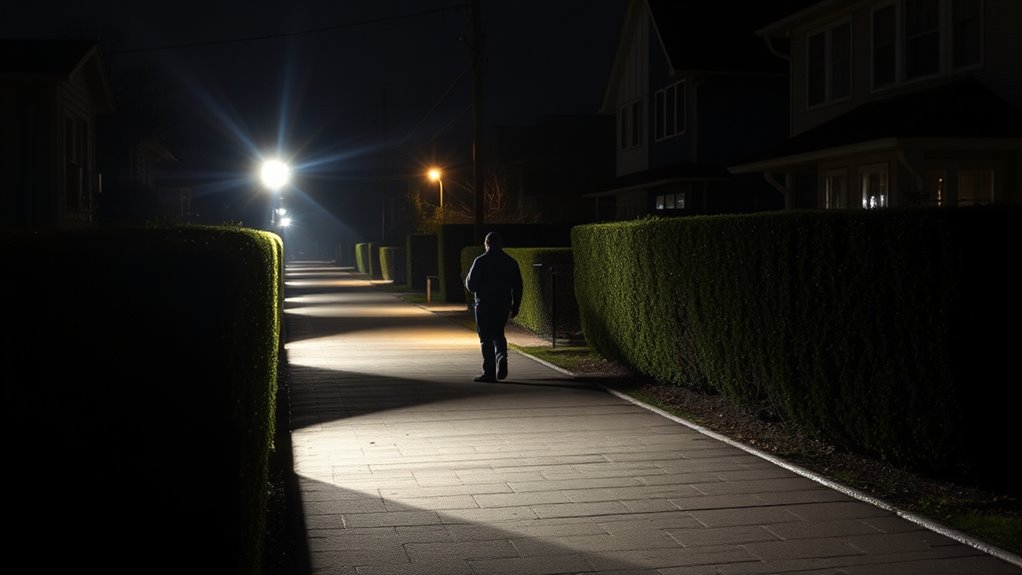
Motion-activated lighting has become a popular crime deterrent because it instantly alerts you to movement near your property. It’s effective because it startles intruders and signals that someone is watching. You can enhance this system with solar panels, making the lights eco-friendly and reducing energy costs. Decorative fixtures can also blend security with style, making your outdoor space attractive while functional. To maximize effectiveness:
- Use motion sensors with adjustable sensitivity to prevent false alarms.
- Install solar-powered lights for sustainability and savings.
- Choose decorative fixtures that complement your landscape and provide broad coverage.
- Incorporate energy-efficient lighting options to further reduce electricity use and support environmental sustainability.
This combination of technology and design helps maintain security without sacrificing aesthetics, making your property less appealing to potential intruders.
The Importance of Consistent Lighting in High-Risk Areas
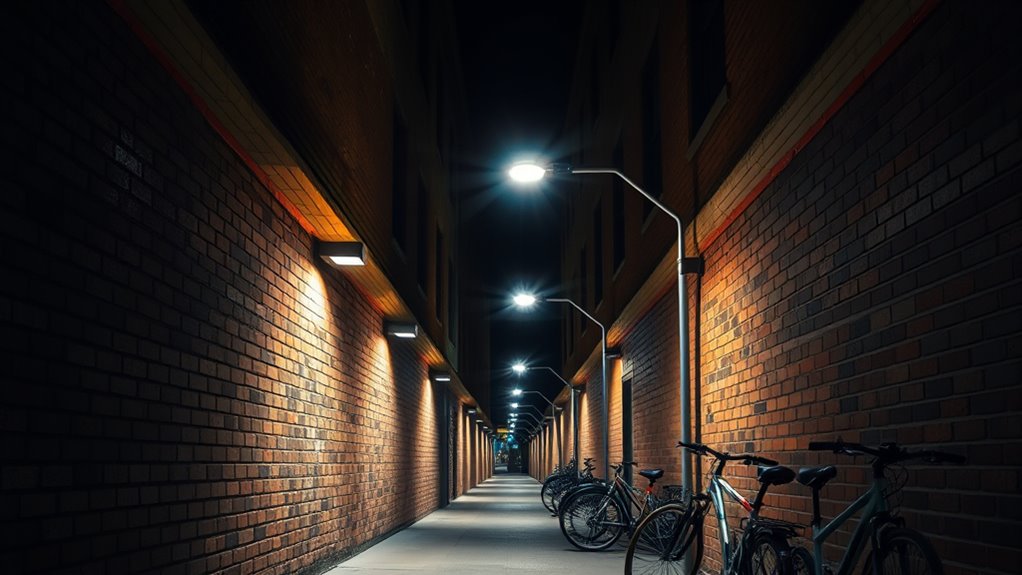
While motion-activated lighting effectively deters intruders by providing sudden illumination, relying solely on it can leave high-risk areas vulnerable during periods of inactivity. Consistent lighting ensures these areas remain illuminated throughout the night, reducing hiding spots and discouraging criminal activity. Regularly maintained lighting also supports security patrols, allowing officers to navigate confidently and identify issues quickly. Additionally, consistent lighting enhances emergency response efforts by making it easier for responders to locate and access key points swiftly. When lighting is unpredictable or inconsistent, it creates shadows and dark corners that criminals can exploit, increasing the risk of incidents. Proper maintenance of lighting systems is essential to prevent malfunctions that could create vulnerabilities. To maximize safety, you should implement a well-planned lighting schedule that maintains uniform illumination across high-risk zones at all times.
Color Temperature and Its Influence on Crime Deterrence
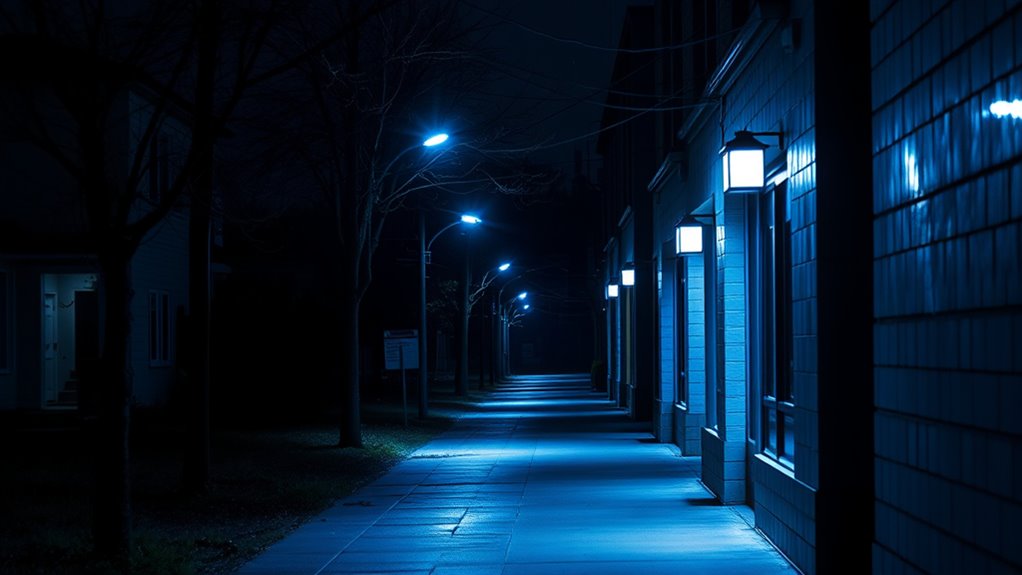
The color temperature of outdoor lighting plays a crucial role in crime deterrence by influencing how secure a space appears. Cooler color temperatures (around 5000K) tend to create a bright, alert atmosphere that can enhance visibility and reduce hiding spots. Conversely, warmer temperatures (around 2700K) produce a softer glow, which may feel more inviting but less effective for security. The psychological impact is significant—higher color temperatures can make areas seem more vigilant and less inviting to potential offenders. To maximize crime deterrence, consider these points:
- Use cooler color temperatures for high-risk zones to boost visibility.
- Avoid overly warm lighting that creates a cozy but less secure feeling.
- Balance lighting to ensure clear sightlines and a sense of alertness.
- Proper lighting placement and environmental considerations can further enhance security and safety.
Integrating Smart Lighting Systems for Enhanced Security
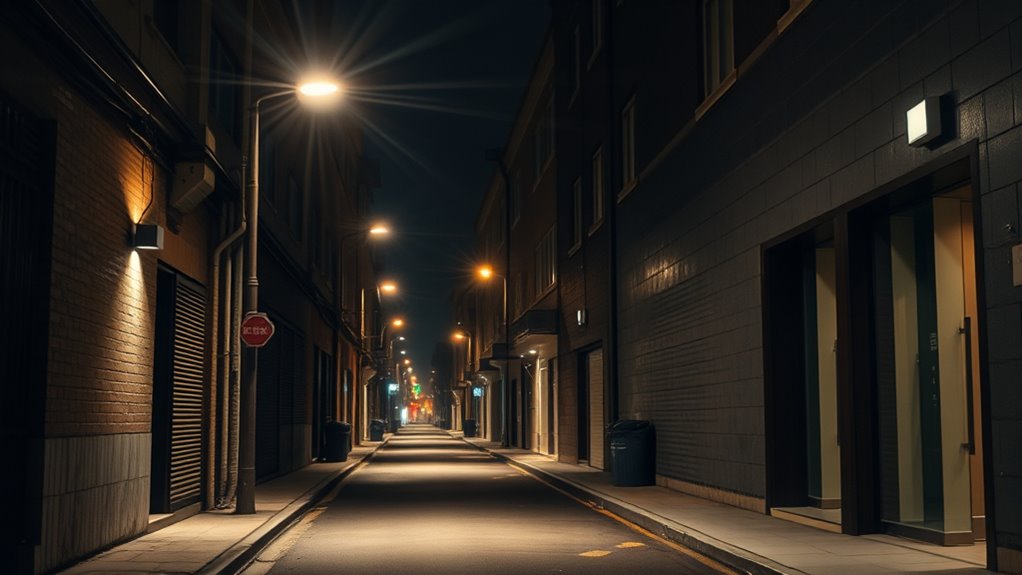
Smart lighting systems take outdoor security to the next level by offering dynamic control and automation. With smart lighting, you can adjust brightness, color, and timing based on real-time conditions, making your property less attractive to criminals. These systems can be programmed to activate or brighten when motion is detected, instantly alerting you to suspicious activity and increasing crime prevention. You can also set schedules to ensure well-lit areas during high-risk times, even when you’re away. Integrating smart lighting with security cameras and alarms creates a seamless security network, enhancing overall safety. By leveraging smart lighting, you actively deter crime through adaptive illumination, reducing blind spots and confusing potential intruders. This proactive approach strengthens your property’s defenses, making it a less appealing target for criminal activity.
Community Engagement and Maintenance of Lighting Systems
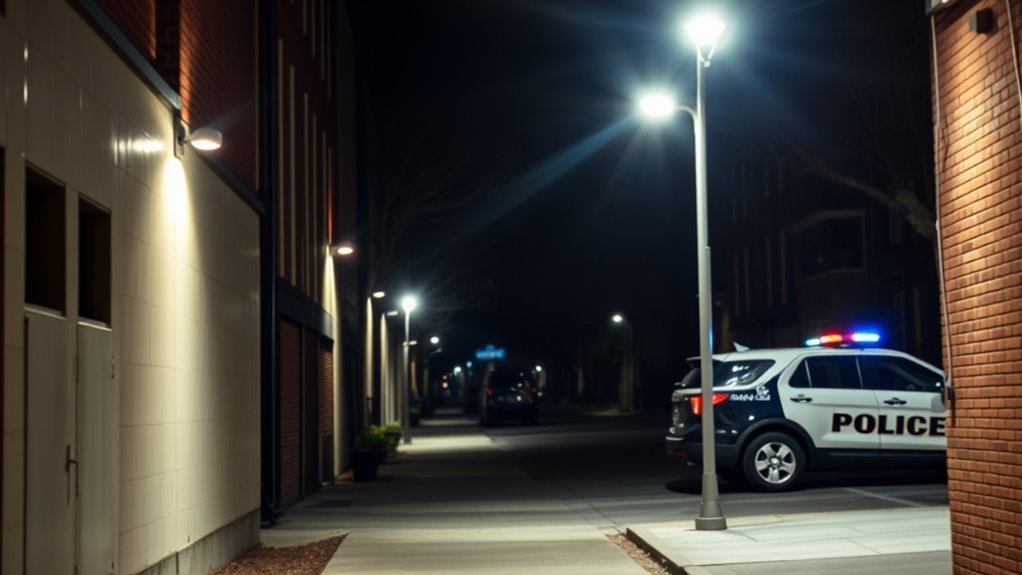
Community engagement plays a crucial role in maintaining effective lighting systems that deter crime. When residents stay involved, they foster a sense of ownership and guarantee lighting remains functional and well-maintained. To strengthen this, consider these actions:
Active community involvement ensures lighting stays effective and crime remains deterred.
- Organize neighborhood watch programs that include regular checks on street lighting and report issues promptly.
- Increase public awareness about the importance of proper lighting and how it reduces crime, encouraging residents to participate actively.
- Collaborate with local authorities to schedule routine maintenance, ensuring lighting systems stay effective and reliable.
Frequently Asked Questions
How Do Lighting Strategies Differ for Various Types of Crime?
When considering how lighting strategies differ for various crimes, you focus on enhancing pedestrian safety and property visibility. For theft prevention, you install brighter, evenly distributed lights around properties. To deter assault or vandalism, you increase lighting in dark alleyways and secluded areas. By tailoring lighting to specific crime types, you create safer environments, reducing opportunities for criminal activity and helping you feel more secure during nighttime hours.
Can Lighting Improvements Replace Other Security Measures Effectively?
Sure, lighting improvements can seem like magic, but don’t ditch security measures just yet. You still need lighting maintenance and durable fixtures to keep the glare away and the bulbs burning. While good lighting can deter crime, it’s no silver bullet. Combine it with cameras, alarms, and patrols for real security. Relying solely on lighting, no matter how shiny, leaves gaps that clever crooks will exploit.
What Are Cost-Effective Lighting Solutions for Small Communities?
For small communities, cost-effective lighting solutions are essential. You should consider LED lighting, which offers high efficiency and long-term savings, making it a smart choice in your cost analysis. Explore funding options like grants or community fundraising to cover installation costs. Additionally, prioritize strategic placement of lights in high-traffic areas, alleys, and entrances, ensuring maximum crime deterrence without overspending. This approach provides safety without stretching your budget.
How Does Seasonal Lighting Variation Impact Crime Deterrence?
You might notice that seasonal illumination influences crime seasonality, with darker months often seeing higher crime rates. During winter, limited daylight and reduced lighting can create hiding spots, making your community more vulnerable. Conversely, enhanced lighting during these times can disrupt criminal activity and improve safety. By adjusting your lighting strategies seasonally, you actively deter crime, reinforce safety, and respond effectively to changing crime patterns throughout the year.
Are There Privacy Concerns With Advanced Smart Lighting Systems?
You might wonder if advanced smart lighting systems raise privacy concerns or threaten data security. These systems collect data on movement and usage patterns, which could be misused if not properly protected. While they enhance safety and deter crime, you should guarantee robust privacy measures and encryption are in place to prevent unauthorized access. Being aware of data security risks helps you enjoy the benefits without compromising your privacy.
Conclusion
By implementing these proven lighting strategies, you can substantially deter crime and enhance safety. But don’t overlook one vital element—how you manage and adapt your lighting over time. The true power lies in continuous monitoring and smart technology, revealing a future where crime becomes even harder to predict. Are you ready to access this potential and transform your community’s security? The next step could make all the difference.
